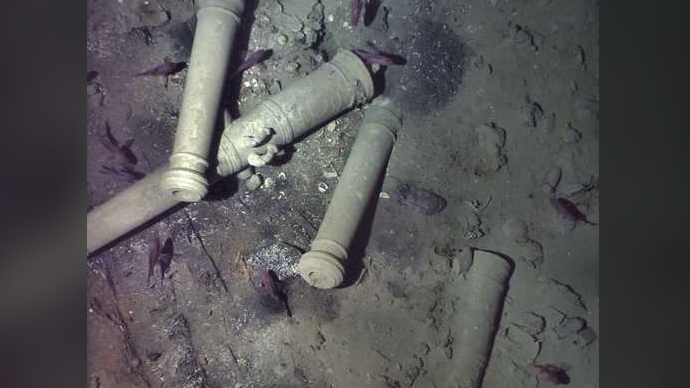Colombia moves to salvage immense treasure from sunken Spanish galleon
The treasure is estimated to be worth about $17 billion today.

The Colombian government has fired a legal broadside against rival claimants for an immense treasure on a sunken Spanish galleon, with a presidential decree calling for salvage companies to register to recover it.
Earlier this month, the Colombian government announced that salvagers would have to submit a detailed inventory of everything they found on the San José shipwreck, which was discovered near the Colombian coast in 2015, Agence France-Presse reported.
British warships sank the San José more than 300 years ago, when it was laden with roughly 200 tons (180 metric tons) of gold, silver and jewels — a treasure estimated to be worth about $17 billion today — destined for France, which was then allied with the Spanish royal court. The sea battle resulted in the galleon — and its treasure — sinking somewhere near the Barú Peninsula, south of Cartagena, Colombia.
Related: Sunken treasures: The curious science of 7 famous shipwrecks
Spain says the San José was a Spanish ship of state when it was sunk, and so according to international conventions, Spain still owns everything on board. A Bolivian Indigenous group, the Qhara Qhara nation, is also claiming the treasure, saying the Spanish forced their ancestors to mine most of it in the 16th century.
In 2018, the United Nations Educational, Scientific and Cultural Organization (UNESCO) advised Colombia not to "commercially exploit" — in other words, salvage — the shipwreck, but the latest move signals the intent of Colombia's government to salvage it anyway, according to the Associated Press.
Treasure ship
According to the Spanish naval history website Todo a Babor ("All to Port"), the San José was a 62-gun galleon of the Spanish navy during the War of the Spanish Succession, a decade-long conflict that embroiled most of the major powers of Europe after the death of the childless Charles II of Spain in 1700.
Get the world’s most fascinating discoveries delivered straight to your inbox.
At the end of May 1708, the San José led a treasure fleet of three warships and 14 merchant vessels from Portobelo in Panama to Cartagena, where the ships planned to shelter during the approaching hurricane season. Both regions were then under Spanish colonial rule.
But the Spanish fleet was intercepted in early June 1708 near the Barú Peninsula by a British Royal Navy squadron of five warships. The ensuing battle was a complete victory for the British; the San José exploded when its stores of gunpowder detonated, and it sank with almost 600 crewmembers and its treasure on board. In the early 1980s, a U.S. company called Sea Search Armada claimed to have located the San José shipwreck and proposed a deal to the Colombian government to share the treasure, National Geographic reported. But the government declined to give permission for the shipwreck's salvage; a lawsuit by the company was eventually overturned in a U.S. court.
In 2015, the Colombian government announced that its navy had located the San José shipwreck at a different location. According to the BBC, Colombia passed a law in 2013 proclaiming that all shipwrecks in its waters are part of the country's national heritage, and the government estimates that there are up to 1,200 such wrecks.
Related: Stunning photos capture eerie underwater shipwrecks
Shipwreck search
The Colombian navy discovered the San José shipwreck in part thanks to a seafloor search by the Woods Hole Oceanographic Institution (WHOI), a private research and educational nonprofit based in Massachusetts.
Rob Munier, WHOI's vice president for marine facilities and operations, told Live Science that the institution was contracted for the search by a British maritime archaeology company, which itself had contracted to the Colombian government. WHOI scientists and engineers made more than two trips to the region over several months, searching with the institution's REMUS 6000 autonomous underwater vehicle (AUV), Munier said. (In 2011, WHOI's REMUS 6000 had been used to find the wreckage of the downed airliner Air France 447 off the coast of Brazil.)
The AUV first searched with side scan sonar equipment, which creates a three-dimensional image of swaths of the seafloor, and it found the San José wreck at a depth of about 2,000 feet (600 meters). For the later investigations, the AUV's sonar equipment was replaced with cameras to capture images. Very little sea life had grown on the shipwreck during its 300 years underwater, partly because of its depth, and so its distinctive cannons and other artifacts were still clearly visible, Munier said.
For now, the wreck of the San José and its multibillion-dollar treasure lie on the seafloor off the Colombian coast, and no physical steps have been taken to salvage it. The government estimates it will cost about $70 million to salvage what it calls a "national treasure," and it wants it put on display in a museum to be built in Cartagena, according to AFP.
Originally published on Live Science.
Tom Metcalfe is a freelance journalist and regular Live Science contributor who is based in London in the United Kingdom. Tom writes mainly about science, space, archaeology, the Earth and the oceans. He has also written for the BBC, NBC News, National Geographic, Scientific American, Air & Space, and many others.



